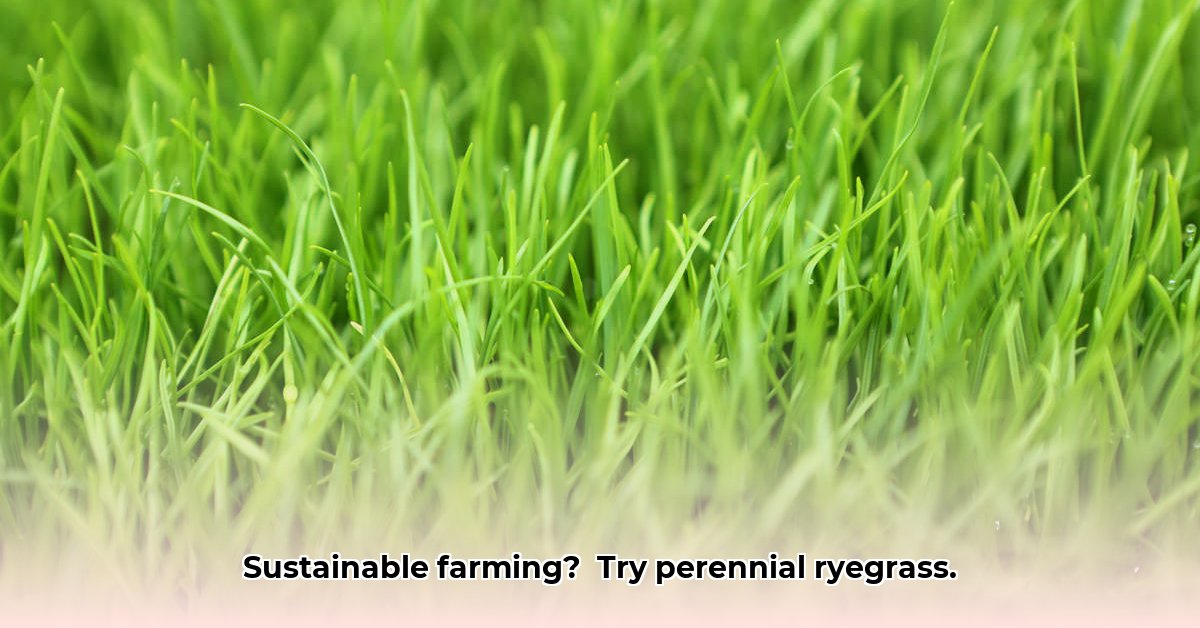
Choosing the right grass for your pasture is a crucial decision impacting profitability and environmental sustainability. Perennial ryegrass, particularly varieties available at Tractor Supply, offers a compelling solution for building a thriving and resilient pasture. For more information on winter rye options, check out this helpful resource. This guide provides a step-by-step approach to maximizing your pasture's potential using perennial ryegrass, blending practical advice with sustainable farming principles.
Understanding the Benefits of Perennial Ryegrass
Perennial ryegrass offers several advantages over annual varieties, making it a worthwhile investment for long-term pasture health. Its deep root system improves drought tolerance by accessing deeper soil moisture. This deeper root system also enhances nutrient uptake, leading to healthier plants and a more robust pasture.
This improved water retention and nutrient absorption translate to a naturally improved soil structure. The extensive root network helps prevent erosion and creates a better environment for your plants to flourish. This inherent resilience makes it particularly valuable in the context of climate change and its unpredictable impact on farming.
But not all perennial ryegrasses are created equal. The varieties available at Tractor Supply represent a range of options, and careful selection is key to success.
Selecting the Right Perennial Ryegrass for Your Needs
Tractor Supply offers several perennial ryegrass varieties, each with unique characteristics. The ideal choice depends on several factors:
1. Climate and Soil Conditions
Consider your region's average temperatures, rainfall, and soil type. Some varieties, such as Groundwork, excel in drought conditions. Others, like Greenview blends, might be better suited to wetter or more variable climates. A pre-planting soil test is critical; it reveals pH levels, nutrient content, and drainage capabilities, allowing you to select a variety that will thrive.
2. Livestock Requirements
Different livestock have different nutritional needs. The nutritional profile of various ryegrass varieties can vary, so understanding your livestock's dietary requirements will help you select a grass that maximizes their health and productivity.
3. Tractor Supply's Offerings: A Quick Comparison
While specific product details may vary seasonally, consider these general characteristics:
| Product Name | Key Features | Considerations |
|---|---|---|
| Groundwork Perennial Ryegrass | Excellent drought tolerance; improves soil health; | Might need careful management in consistently wet or poorly drained areas. |
| Greenview Perennial Ryegrass Blend | Blend of ryegrasses for improved wear tolerance and yield; | Ideal for high-traffic areas or areas with varied soil conditions. |
Remember: Consult your local agricultural extension agent for personalized advice. They possess in-depth knowledge of your region's specific conditions and can make targeted recommendations.
Planting and Maintaining Your Ryegrass Pasture: A Practical Guide
Successfully establishing a perennial ryegrass pasture requires careful planning and execution. Follow these steps for optimal results:
Soil Preparation: Remove weeds, rocks, and debris. Amend the soil based on your soil test results, adjusting pH and nutrient levels as needed. Ensure proper drainage to prevent waterlogging.
Seeding: Follow the seeding rate instructions on the seed packaging. Even seeding ensures uniform growth.
Fertilization: Use a balanced pasture fertilizer at the recommended rate, avoiding over-fertilization.
Watering: Water regularly, especially during establishment, to promote germination and root development.
Weed Control: Address weeds promptly to prevent competition with your ryegrass.
Grazing Management: Implement rotational grazing to prevent overgrazing and allow for regrowth.
Maximizing Yield and Sustainable Practices
While choosing the right ryegrass is crucial, ongoing management is essential for long-term success and sustainable pasture production.
Regular Monitoring: Keep track of pasture growth, soil health, and livestock performance. Employ technology such as drone or satellite imagery for precise insights. This proactive approach allows for timely adjustments in grazing management and fertilization practices, preventing problems before they impact your yield.
Data-Driven Decisions: Track pasture growth rates, grazing patterns, and soil nutrient levels to refine your strategy. Data-driven decisions are key to optimizing your pasture management, ensuring you're consistently making informed choices.
Adaptive Management: Be prepared to adapt your practices based on observations and new information. Sustainable farming is an ongoing process of learning and improvement, requiring flexibility and continuous evaluation.
Long-Term Sustainability: Building a Resilient Pasture
Sustainable pasture management extends beyond selecting the right grass. Consider integrating these long-term perspectives:
- Biodiversity: Diversifying your pasture with legumes and other grasses improves resilience against pests, diseases, and climate variability. A diverse pasture system is inherently more robust and sustainable.
- Soil Health: Regular soil testing and appropriate amendments ensure your soil remains fertile and productive. Healthy soil is the foundation of a healthy pasture.
- Continuous Learning: Stay abreast of advancements in pasture management, utilizing the collective knowledge and experiences of other farmers and agricultural experts.
By incorporating these strategies, you can build a thriving and resilient perennial ryegrass pasture that supports your livestock, enhances environmental sustainability, and contributes to the long-term health of your land.